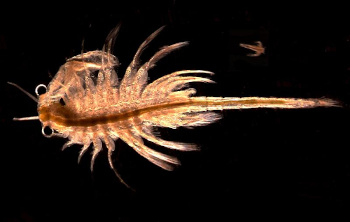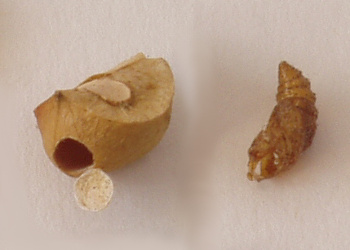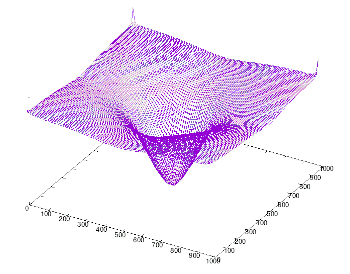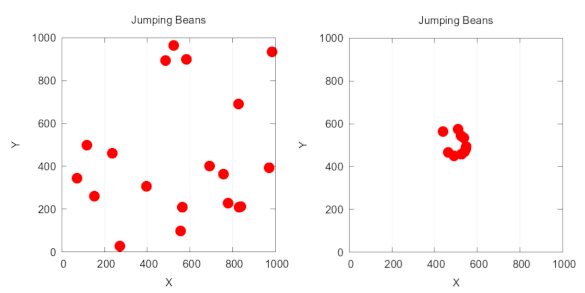Jumping Beans
April 17, 2023
I'm a member of the
baby boomer generation, and
comic books were a principal source of my
childhood entertainment. Comic books at that time typically
cost ten
cents, which is slightly more than a
dollar in
today's money. I wasn't able to pay that much, but there was an option. In those days, before
ubiquitous supermarkets,
neighborhood grocery stores were common; and, there was one located across the
street from our
apartment. It was owned by a
family of
industrious Lebanese immigrants who would buy used comic books for a
penny and resell them for two cents. That's how I was able to read
science fiction comics such as
Mystery in Space with the appearance of
Space Cabbie.
One feature of
1950s comic books was the
ads for
novelty items. These were for such things as
ant farms and
Sea Monkeys. The Sea Monkeys were sold as the
dormant eggs of the
brine shrimp, Artemia, along with a
nutrient mixture that allowed the eggs to
hatch when mixed with
water. Sea Monkeys were so named from the supposed resemblance of the shrimp
tails to
monkey tails, and the ads had
drawings of
humanoid creatures quite unlike these
animals.

The brine shrimp, Artemia monica. These are usually less than a centimeter in length, and about 4 millimeters in width.
(Wikimedia Commons image by djpmapleferryman.)
One novelty item with some
physics behind its operation was
X-ray eyeglasses. While the ads showed these as a way to view the
bones in your
hand and see through
clothing, the
small print advised that what was seen was an
illusion. The illusion was caused by the
diffraction of
light passing through a small
hole, through the
vanes of a feather, or an actual
diffraction grating. Eyeglasses using the small hole method were first
patented in 1906.[1] In 1971,
Harold von Braunhut (1926-2003), the
inventor of the Amazing Sea-Monkeys, patented eyeglasses incorporating
plastic lenses processed to achieve a
stress-induced birefringence to produce the
X-ray illusion.[2]
The
ultimate goal of
marketing is to
make money from
sales of an
inexpensive and low
quality item. Today's prime example would be
chicken wings; and, in the comic books, it was
Mexican jumping beans. These are
seed pods of the
Mexican tree,
Sebastiania pavoniana,
infected with
larva of the small
moth,
Cydia saltitans. Larvae of this moth bore into the
immature green seed pods, and they
devour the seeds from the inside. The larvae abruptly curl and uncurl inside the seed pod causing the beans to jump.

A jumping bean of the Mexican tree, Sebastiania pavoniana, along with the larva of the small moth, Cydia saltitans, that infects it.
The larvae escape through an opening at the end of the seed pods.
(Wikimedia Commons image, modified, by NobbiP.)
These jumping beans have a long
shelf-life that allowed
mail order sales from comic book ads, and they jump several times a
minute when held in a hand and are thereby
heated. Since these beans jump more at higher
temperatures, Devon McKee, presently at the
University of California, Santa Cruz, and
A. Pasha Tabatabai from the
Department of Physics of
Seattle University (Seattle, Washington) thought that this process was a way in which the larvae are able to relocate from a potentially
lethal sunny spot to
tree shade.[3-4]
As the
researchers state,
organisms have
strategies for
motion that ensure their
survival.[3] The larvae inside the seed pods execute their jumps
blindly, and McKee and Tabatabai found that these jumps in
random directions having no
correlation to previous jumps are a
random walk.[4] Given enough
time, the jumping beans will always find their way from sun to shade.[4]
The researchers used
image analysis to determine the
quantitative attributes of the temperature-induced jumping, and they developed a
computer simulation of the motion of the beans.[3] While a random walk is a slow method of travel, such a walk will visit every
point in the
plane if given enough time; so, the larvae will find the shade that they need.[3-4]
While their
paper in
Physical Review E is unfortunately
paywalled, the
idea is simple enough for me to
program my own computer simulation, the
C source code for which can be found
here. This program utilizes two very useful
Linux applications; namely,
Gnuplot, for generating
images of the instantaneous locations of the jumping beans, and
ffmpeg, which allows stitching these images together as
frames in a
video. The program source code is
commented to describe how these applications are used.
In my simulation, there's a large shade tree at the center of a
field. The temperature of the field is 40°C, and this tapers to 20°C directly under the tree. A
surface plot of the temperature distribution is shown in the following figure. The jumping beans are placed at random positions on the field outside the influence of the tree.

Temperatures within the simulated field.
The field is 1000 by 1000, and a shade tree with branches extending to a circular radius of 200 is placed at (500,500). The temperature tapers from 40°C to 20°C towards the center of the tree.
(The surface plot is an edited Gnumeric image. Click for larger image.)
When the
rate of a process depends on temperature, we immediately think of the
Arrhenius equation,

in which
Ea is an
activation energy,
kB is the
Boltzmann constant,
T is the temperature,
A is a
constant, and
k is the rate. While we could find values of these to
fit our jumping bean problem, I instead used the Arrhenius
rule-of-thumb that rates double for every 5°C temperature increase, and I set the jump rate in the field at 8, decreasing by factors of two to zero at the center of the tree. You can see the starting positions of twenty beans and their positions after 20,000 jumps in the following figure. A video of the jumping process is also provided.

The starting positions of twenty beans (left) and their positions after 20,000 jumps in the simulation (right). In this case, twelve of the twenty beans found shade under the central tree, and the eight others may have found a shade tree outside this patch. (Click for larger image.)
 Video is released under a Creative Commons License
Video is released under a Creative Commons License.
Right click to download MP4 video file.
References:
- George W Macdonald, "Optical device," US Patent No. 839,016, December 18, 1906 (Via Google Patents).
- Harold N Braunhut, "Optical device for simulating optical images," US Patent No. 3,592,533, July 13, 1971 (Via Google Patents).
- Devon McKee and A. Pasha Tabatabai, "Mexican jumping beans exhibit diffusive motion," Phys. Rev. E, vol. 107, no. 1 (January 25, 2023, article no. 014609, DOI:https://doi.org/10.1103/PhysRevE.107.014609.
- James R. Riordon, "Jumping beans’ random strategy always leads to shade — eventually," Science News, January 5, 2023.
Linked Keywords: Baby boomer generation; comic book; childhood; entertainment; cost; cent (currency); dollar; inflation; today's money; ubiquitous; supermarket; neighborhood; grocery store; street; apartment; family; diligence; industrious; lebanon; Lebanese; immigration; immigrant; penny; science fiction; Mystery in Space; Space Cabbie; 1950s; advertising; ad; novelty item; formicarium; ant farm; Sea Monkey; microbial cyst; dormant egg; brine shrimp; Artemia; nutrient; mixture; hatchling; hatch; water; tail; monkey; drawing; humanoid creature; animal; centimeter; millimeter; Wikimedia Commons; djpmapleferryman; physics; X-ray specs; X-ray eyeglasses; bone; hand; clothing; fine print; small print; optical illusion; diffraction; light; transmittance; passage; hole; pennaceous feather; feather vane; diffraction grating; patent; patented; Harold von Braunhut (1926-2003); invention; inventor; plastic; lens (optics); stress-induced birefringence; X-ray; ultimate; goal; marketing; profit (accounting); make money; sales; cost; inexpensive; quality (business); Buffalo wing; chicken wing; Mexican jumping bean; seed; husk; pod; Mexico; Mexican; tree; Sebastiania pavoniana; infection; infected; larva; moth; Cydia saltitans; immature; eat; devour; NobbiP; shelf-life; mail order; minute; heat; heated; temperature; University of California, Santa Cruz; A. Pasha Tabatabai; Department of Physics; Seattle University (Seattle, Washington); lethality; lethal; shade tree; tree shade; research; researchers; organism; strategy; motion (physics); self-preservation; survival; blindness; blindly; randomness; random; correlation; random walk; time; image analysis; quantification (science); quantitative attribute; computer simulation; point (geometry); plane (geometry); scientific literature; paper; Physical Review E; paywall; paywalled; idea; computer program; C source code; jumping beans.c; Linux; application software; Gnuplot; digital image; ffmpeg; frame (video); video clip; comment (computer programming); field (agriculture); surface plot; tree branch; circle; circular; radius; Gnumeric; rate (mathematics); Arrhenius equation; activation energy; Boltzmann constant; constant (mathematics); curve fitting; rule-of-thumb; Cartesian coordinate system; starting position; Creative Commons License; MP4 video file; Google Patents.